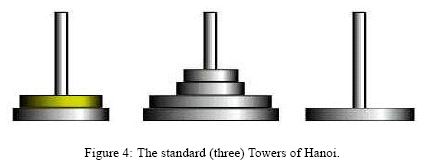POJ1958 Strange Towers of Hanoi [递推]
Strange Towers of Hanoi
| Time Limit: 1000MS | Memory Limit: 30000K | |
| Total Submissions: 3117 | Accepted: 2004 |
Description
Charlie Darkbrown sits in another one of those boring Computer Science lessons: At the moment the teacher just explains the standard Tower of Hanoi problem, which bores Charlie to death!

The teacher points to the blackboard (Fig. 4) and says: "So here is the problem:
- There are three towers: A, B and C.
- There are n disks. The number n is constant while working the puzzle.
- All disks are different in size.
- The disks are initially stacked on tower A increasing in size from the top to the bottom.
- The goal of the puzzle is to transfer all of the disks from tower A to tower C.
- One disk at a time can be moved from the top of a tower either to an empty tower or to a tower with a larger disk on the top.
So your task is to write a program that calculates the smallest number of disk moves necessary to move all the disks from tower A to C."
Charlie: "This is incredibly boring—everybody knows that this can be solved using a simple recursion.I deny to code something as simple as this!"
The teacher sighs: "Well, Charlie, let's think about something for you to do: For you there is a fourth tower D. Calculate the smallest number of disk moves to move all the disks from tower A to tower D using all four towers."
Charlie looks irritated: "Urgh. . . Well, I don't know an optimal algorithm for four towers. . . "
Problem
So the real problem is that problem solving does not belong to the things Charlie is good at. Actually, the only thing Charlie is really good at is "sitting next to someone who can do the job". And now guess what — exactly! It is you who is sitting next to Charlie, and he is already glaring at you.
Luckily, you know that the following algorithm works for n <= 12: At first k >= 1 disks on tower A are fixed and the remaining n-k disks are moved from tower A to tower B using the algorithm for four towers.Then the remaining k disks from tower A are moved to tower D using the algorithm for three towers. At last the n - k disks from tower B are moved to tower D again using the algorithm for four towers (and thereby not moving any of the k disks already on tower D). Do this for all k 2 ∈{1, .... , n} and find the k with the minimal number of moves.
So for n = 3 and k = 2 you would first move 1 (3-2) disk from tower A to tower B using the algorithm for four towers (one move). Then you would move the remaining two disks from tower A to tower D using the algorithm for three towers (three moves). And the last step would be to move the disk from tower B to tower D using again the algorithm for four towers (another move). Thus the solution for n = 3 and k = 2 is 5 moves. To be sure that this really is the best solution for n = 3 you need to check the other possible values 1 and 3 for k. (But, by the way, 5 is optimal. . . )
Input
Output
Sample Input
No input.
Sample Output
REFER TO OUTPUT.
分析:题目大意就是要求你解出n个盘子4座塔的Hanoi问题的最少步数,不需要输入,直接输出n为1-12的所有答案即可。我们知道,一般的三塔Hanoi问题的递推式是d[i]=d[i-1]*2+1,意思就是先将i-1个盘子放在第二个塔上,再把最后一个放在第三个塔上,再将i-1个盘子放在第三个塔上(如果这个不知道就自己去玩一下Hanoi),当然这种方法实质上是将i个盘子的问题先转化为i-1个盘子的问题。那么做这题就可以用类似的思维,先将i个盘子的四塔问题转化为j个盘子的三塔问题(0<=j<=i),令f[i]为i个盘子的四塔问题的答案,则f[i]=min(f[i],f[j]*2+d[i-j])。实际上也就等效于先做j个盘子的四塔问题,再做i-j个盘子的三塔问题,再做一次j个盘子的四塔问题。那么答案就很容易了。
Code:
#include<cstdio>
#include<cstring>
#include<cstdlib>
#include<cmath>
#include<iostream>
#include<iomanip>
#include<algorithm>
#define Fi(i,a,b) for(int i=a;i<=b;i++)
using namespace std;
int d[],f[];
int main()
{
Fi(i,,)d[i]=d[i-]*+;memset(f,0x3f3f3f3f,sizeof(f));
f[]=;Fi(i,,)Fi(j,,i)f[i]=min(f[i],*f[j]+d[i-j]);
Fi(i,,)cout<<f[i]<<endl;return ;
}
POJ1958 Strange Towers of Hanoi [递推]的更多相关文章
- POJ-1958 Strange Towers of Hanoi(线性动规)
Strange Towers of Hanoi Time Limit: 1000MS Memory Limit: 30000K Total Submissions: 2677 Accepted: 17 ...
- poj1958——Strange Towers of Hanoi
The teacher points to the blackboard (Fig. 4) and says: "So here is the problem: There are thre ...
- poj1958 strange towers of hanoi
说是递推,其实也算是个DP吧. 就是4塔的汉诺塔问题. 考虑三塔:先从a挪n-1个到b,把最大的挪到c,然后再把n-1个从b挪到c,所以是 f[i] = 2 * f[i-1] + 1; 那么4塔类似: ...
- POJ 1958 Strange Towers of Hanoi 解题报告
Strange Towers of Hanoi 大体意思是要求\(n\)盘4的的hanoi tower问题. 总所周知,\(n\)盘3塔有递推公式\(d[i]=dp[i-1]*2+1\) 令\(f[i ...
- POJ 1958 Strange Towers of Hanoi
Strange Towers of Hanoi Time Limit: 1000MS Memory Limit: 30000K Total Submissions: 3784 Accepted: 23 ...
- Strange Towers of Hanoi POJ - 1958(递推)
题意:就是让你求出4个塔的汉诺塔的最小移动步数,(1 <= n <= 12) 那么我们知道3个塔的汉诺塔问题的解为:d[n] = 2*d[n-1] + 1 ,可以解释为把n-1个圆盘移动到 ...
- POJ1958:Strange Towers of Hanoi
我对状态空间的理解:https://www.cnblogs.com/AKMer/p/9622590.html 题目传送门:http://poj.org/problem?id=1958 题目要我们求四柱 ...
- [POJ1958][Strange Tower of Hanoi]
题目描述 求解 \(n\) 个盘子 \(4\) 座塔的 Hanoi 问题最少需要多少步 问题分析 考虑 \(3\) 座塔的 Hanoi 问题,记 \(f[i]\) 表示最少需要多少步, 则 \(f[i ...
- Strange Towers of Hanoi
题目链接:http://sfxb.openjudge.cn/dongtaiguihua/E/ 题目描述:4个柱子的汉诺塔,求盘子个数n从1到12时,从A移到D所需的最大次数.限制条件和三个柱子的汉诺塔 ...
随机推荐
- 使用html5的Geolocation API实现定位
公司有个需求,需要获取用户的位置,所以看了下html5的Geolocation 这个新东西,发现挺好用的. <!DOCTYPE html> <html> <body> ...
- android AsyncTask介绍 AsyncTask和Handler对比
1 ) AsyncTask实现的原理,和适用的优缺点 AsyncTask,是android提供的轻量级的异步类,可以直接继承AsyncTask,在类中实现异步操作,并提供接口反馈当前异步执行的程度(可 ...
- Rabbit MQ 面试题相关
项目中的MQ: #rabbitmq spring.rabbitmq.host=127.0.0.1 主机 spring.rabbitmq.port=5672 端口 spring.rabbitmq.use ...
- LightOJ 1151 - Snakes and Ladders 高斯消元+概率DP
首先来个期望的论文,讲的非常好,里面也提到了使用线性方程组求解,尤其适用于有向图的期望问题. 算法合集之<浅析竞赛中一类数学期望问题的解决方法> http://www.lightoj.co ...
- [Luogu 2341] HAOI2006 受欢迎的牛
[Luogu 2341] HAOI2006 受欢迎的牛 智能推的水题,一看是省选题就给做了,做一半才发现 Tarjan 算法忘干净了. Tarjan 求出SCC,算出每一个 SCC 包含原图的点数(s ...
- Django ORM常用的函数以及修饰词
函数名称或修饰词 说明 filter() 返回符合指定条件的QuerySet exclude() 返回不符合指定条件的QuerySet ordey_by() 串接到QuerySet之后,针对某一指定的 ...
- 【BZOJ1272】Gate Of Babylon [Lucas][组合数][逆元]
Gate Of Babylon Time Limit: 10 Sec Memory Limit: 162 MB[Submit][Status][Discuss] Description Input ...
- 超详细的Java面试题总结(一)之Java基础知识篇
面向对象和面向过程的区别 面向过程: 优点:性能比面向对象高,因为类调用时需要实例化,开销比较大,比较消耗资源;比如单片机.嵌入式开发.Linux/Unix等一般采用面向过程开发,性能是最重要的因 ...
- 【洛谷 P5110】 块速递推(矩阵加速,分块打表)
题目链接 掌握了分块打表法了.原来以前一直想错了... 块的大小\(size=\sqrt n\),每隔\(size\)个数打一个表,还要在\(0\text{~}size-1\)每个数打一个表. 然后就 ...
- 2017-2018-1 20179205《Linux内核原理与设计》第六周作业
<Linux内核原理与设计> 视频学习及操作 给MenuOS增加time和time-asm命令的方法: 1.更新menu代码到最新版 rm menu -rf //强制删除menu, rm ...
